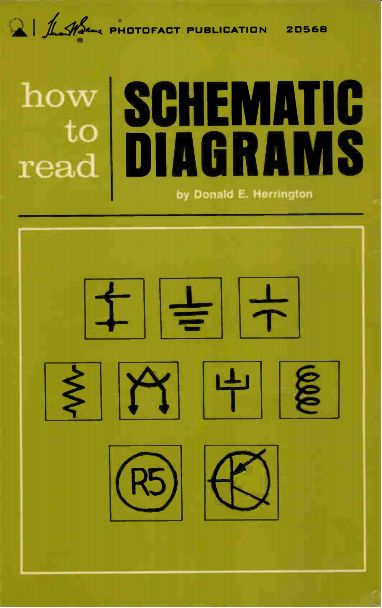AMAZON multi-meters discounts / AMAZON oscilloscope discounts
Contents
SECTION 1--TYPES of ELECTRONIC DIAGRAMS
Schematic Diagrams - Block Diagrams - Chassis-Layout Diagrams - Photos and Pictorial Diagrams - Mechanical Diagrams-Review of Fundamentals
SECTION 2--RESISTORS
What Is a Resistor?-Fixed Resistors-Tapped and Adjust able Resistors-Variable Resistors-Special Resistors
SECTION 3--CAPACITORS
What Is a Capacitor?-Capacitance-Fixed Capacitors- Electrolytic Capacitors-Variable Capacitors-Code Letters
SECTION 4--COILS and TRANSFORMERS
What Is a Coil?-Air-Core Coils-Powdered-Iron Coils- Iron-Core Chokes-Transformers
SECTION 5--ELECTRON TUBES
Diode Tubes-Tube Bases-Triode Tubes-Tube Voltages-Symbols-Tetrode Tubes-Pentode Tubes-Beam-Power Tubes-Pentagrid Tubes-Dual-Section Tubes-Gas-Filled Tubes - Phototubes - Electron-Ray Tubes - Cathode-Ray Tubes-Code Letters
SECTION 6--SEMICONDUCTORS
What Is a Semiconductor? - Rectifiers - Signal Diodes - Transistors-Other Semiconductors
SECTION 7--SWITCHES and RELAYS SPST
Switches-SPDT Switches-Double-Pole Switches- Wafer Switches-Push-Button Switches-Relays
SECTION 8--MISCELLANEOUS COMPONENTS
Antennas-Speakers-Fuses-Circuit Breakers-Lamps- Batteries-Crystals-Vibrators- Microphones-Transducers - Headsets and Earphones - Phono Pickups - Tape Heads - Rotating Machines - Solenoids - Meters - Other Symbols
SECTION 9--CONNECTING the COMPONENTS
Wires-Ground and Chassis Symbols-Other Methods of Denoting Connections - Connecting Devices - Printed Circuits-Component Combinations
SECTION 10--COMBINING the COMPONENTS
Rectifier Circuits-Basic Tube Circuits-Basic Transistor Circuits-Summary
SECTION 11--READING and INTERPRETING SCHEMATIC DIAGRAMS
Radio-Receiver Schematic Analysis-Transistor Radios- From Schematic to Chassis-Other Types of Equipment
APPENDIX A--HOUSE WIRING SYMBOLS
APPENDIX B--ANSWERS to QUESTIONS INDEX
This guide is based on the 1967 book:
How To Read Schematic Diagrams
by Donald E. Herrington
The schematic diagram is the road map of the electronics industry. Although seemingly complicated, it is really easy to follow, once you understand the meanings of the symbols.
The author of How To Read Schematic Diagrams has succeeded in treating the subject simply and thoroughly. Starting with an explanation of the various types of electronic diagrams, you are then shown the schematic symbols for resistors, capacitors, coils and transformers, electronic tubes, and all the other components in a circuit. A section is devoted to the ways these components are connected together, and the schematic symbols for these connections. Finally, with this background, you follow a signal during its journey through a typical superheterodyne receiver. By the time you finish reading this guide, schematic diagrams will have lost their mystery.
Variations likely to be encountered in both symbols and designations are treated at length, for it is these variations which usually cause the greatest confusion. Many symbols are included that, al though not always found in every schematic, are nevertheless important and should be readily recognized by electronics personnel.
This revised, updated version of an old favorite has been popular with the hobbyist and beginner, but technicians and engineers will also find much information of value.
Donald E. Herrington has been a member of the Howard W. Sams Technical Engineering staff for over 15 years. This guide is the culmination of his knowledge of schematic-diagram presentation and his years of experience as an editor in the Technical Book Division. He is also coauthor of the popular SAMS reference volume, Handbook of Electronic Tables and Formulas.
HOWARD W. SAME & CO., INC. THE SOBBS-MERRILL CO., INC.
++++++++++
How to Read Schematic Diagrams by DONALD E. HERRINGTON
SECOND EDITION FIRST PRINTING -- 1967 Copyright (C) 1962 and 1967 by Howard W. Sams & Co., Inc., Indianapolis, Indiana 46206. Printed in the United States of America.
All rights reserved. Reproduction or use, without express permission, of editorial or pictorial content, in any manner, is prohibited. No patent liability is assumed with respect to the use of the information contained herein.
Library of Congress Catalog Card Number: 67-26998
+++++++++
Preface
Who would think of starting on a cross-country trip with out first consulting a road map and plotting the route? Schematic diagrams and road maps have a lot in common-both show the "highways" from one point to another, and both use symbols to designate the various "landmarks." Yet, many students try to embark on a much more important trip--a career in electronics--without first learning how to properly read the "road maps" of the trade.
A simple key to the symbols, such as that included on most maps, is not sufficient for electronic schematics. The high ways, cities, rivers, etc., on the road map are familiar to everyone--you immediately have a picture of what is being represented. The components which make up electronic circuits, however, are not as familiar. Before you can look at an electronic symbol and get a mental picture of its effect on the circuit, you must first know something about the component it represents. This guide was written to help you gain this needed understanding. The comments and letters received have indicated this goal has been accomplished. This second edition contains many added symbols and expanded explanations to keep in step with the latest developments.
Only the theory considered necessary for this knowledge is given. Once the purpose of a component is understood, you will see that its symbol is just as representative as the line across a map is of a highway.
The later sections in this guide show how these components are combined to form circuits. Then, step by step, you follow signals through a schematic diagram of a radio receiver. The function of each stage and the meaning of the information on the schematic is explained.
This guide has been written with the beginner or hobbyist in mind, but it can also serve as an invaluable reference for the technician.
